International Business Law: Legal Issues in Letter of Credit Analysis
VerifiedAdded on 2022/08/13
|14
|4104
|13
Report
AI Summary
This report critically examines the legal issues that arise under the principle of the autonomy of the letter of credit within the context of international business law. It begins by defining and elaborating on the concept of a letter of credit, highlighting its significance as a crucial instrument in international trade, particularly as a payment mechanism. The report discusses the role of the International Chamber of Commerce Uniform Customs and Practice for Documentary Credits (UCP) and explores the potential problems arising from the application of the autonomy principle, especially concerning the strict compliance doctrine. The report examines the relationship between the issuing bank, the buyer, and the seller, the importance of documents over goods, and the fraud exception. It evaluates the solutions provided under UCP600, assessing their effectiveness in addressing inconsistencies in court interpretations and improving the reliability of letters of credit in international transactions. Various case laws are analyzed to support the arguments. The report focuses on whether the solutions given under UCP600 are satisfactory or not.
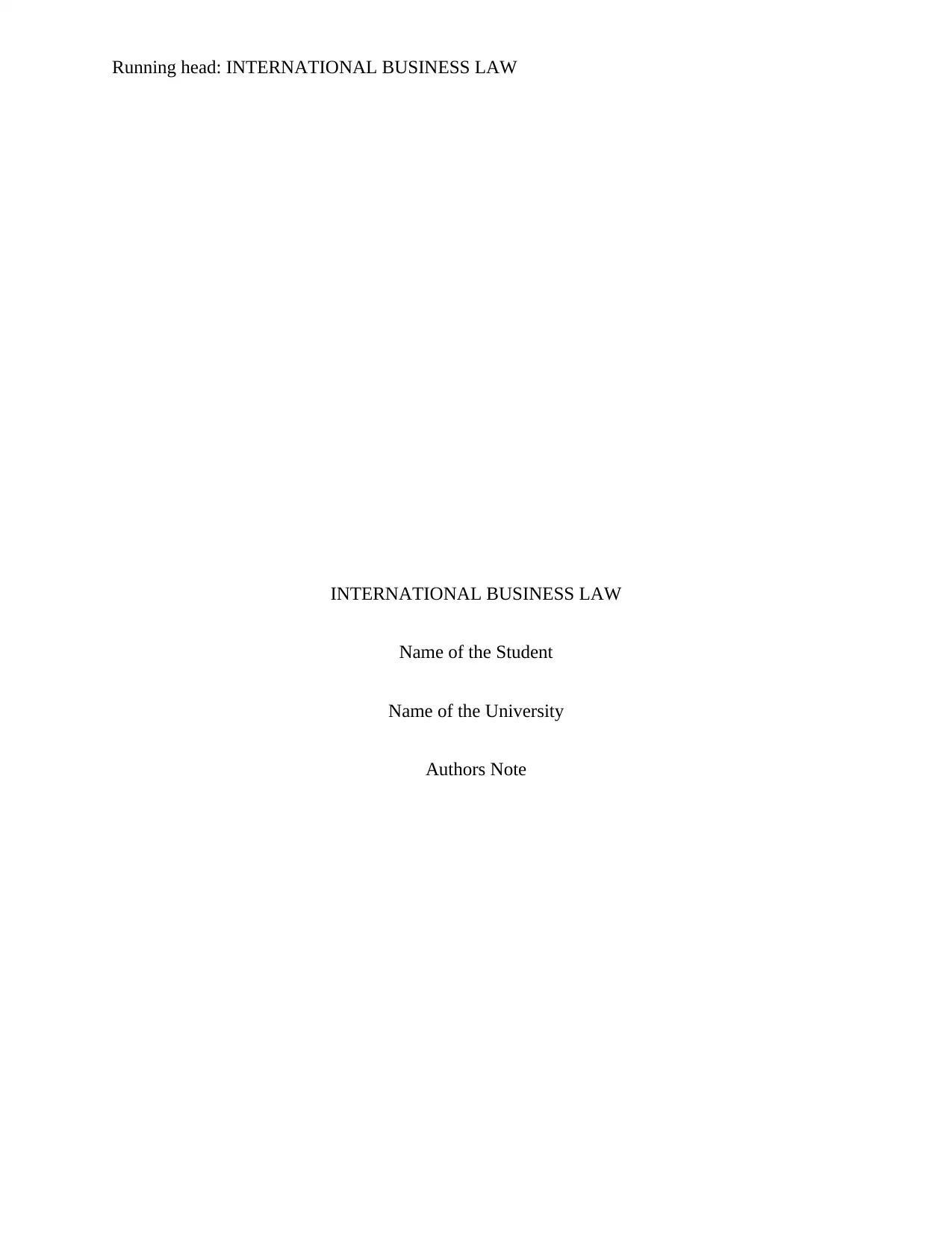
Running head: INTERNATIONAL BUSINESS LAW
INTERNATIONAL BUSINESS LAW
Name of the Student
Name of the University
Authors Note
INTERNATIONAL BUSINESS LAW
Name of the Student
Name of the University
Authors Note
Paraphrase This Document
Need a fresh take? Get an instant paraphrase of this document with our AI Paraphraser
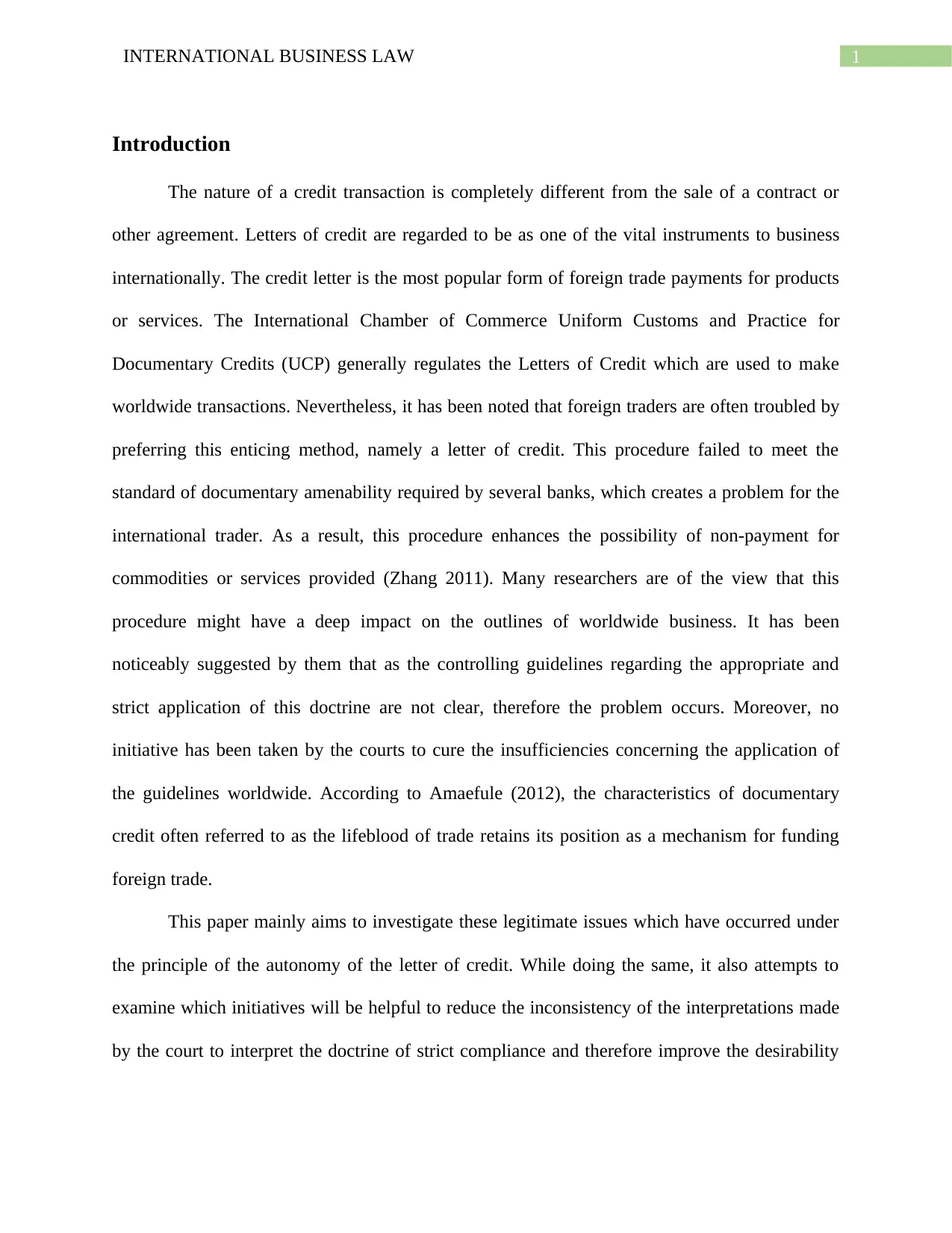
1INTERNATIONAL BUSINESS LAW
Introduction
The nature of a credit transaction is completely different from the sale of a contract or
other agreement. Letters of credit are regarded to be as one of the vital instruments to business
internationally. The credit letter is the most popular form of foreign trade payments for products
or services. The International Chamber of Commerce Uniform Customs and Practice for
Documentary Credits (UCP) generally regulates the Letters of Credit which are used to make
worldwide transactions. Nevertheless, it has been noted that foreign traders are often troubled by
preferring this enticing method, namely a letter of credit. This procedure failed to meet the
standard of documentary amenability required by several banks, which creates a problem for the
international trader. As a result, this procedure enhances the possibility of non-payment for
commodities or services provided (Zhang 2011). Many researchers are of the view that this
procedure might have a deep impact on the outlines of worldwide business. It has been
noticeably suggested by them that as the controlling guidelines regarding the appropriate and
strict application of this doctrine are not clear, therefore the problem occurs. Moreover, no
initiative has been taken by the courts to cure the insufficiencies concerning the application of
the guidelines worldwide. According to Amaefule (2012), the characteristics of documentary
credit often referred to as the lifeblood of trade retains its position as a mechanism for funding
foreign trade.
This paper mainly aims to investigate these legitimate issues which have occurred under
the principle of the autonomy of the letter of credit. While doing the same, it also attempts to
examine which initiatives will be helpful to reduce the inconsistency of the interpretations made
by the court to interpret the doctrine of strict compliance and therefore improve the desirability
Introduction
The nature of a credit transaction is completely different from the sale of a contract or
other agreement. Letters of credit are regarded to be as one of the vital instruments to business
internationally. The credit letter is the most popular form of foreign trade payments for products
or services. The International Chamber of Commerce Uniform Customs and Practice for
Documentary Credits (UCP) generally regulates the Letters of Credit which are used to make
worldwide transactions. Nevertheless, it has been noted that foreign traders are often troubled by
preferring this enticing method, namely a letter of credit. This procedure failed to meet the
standard of documentary amenability required by several banks, which creates a problem for the
international trader. As a result, this procedure enhances the possibility of non-payment for
commodities or services provided (Zhang 2011). Many researchers are of the view that this
procedure might have a deep impact on the outlines of worldwide business. It has been
noticeably suggested by them that as the controlling guidelines regarding the appropriate and
strict application of this doctrine are not clear, therefore the problem occurs. Moreover, no
initiative has been taken by the courts to cure the insufficiencies concerning the application of
the guidelines worldwide. According to Amaefule (2012), the characteristics of documentary
credit often referred to as the lifeblood of trade retains its position as a mechanism for funding
foreign trade.
This paper mainly aims to investigate these legitimate issues which have occurred under
the principle of the autonomy of the letter of credit. While doing the same, it also attempts to
examine which initiatives will be helpful to reduce the inconsistency of the interpretations made
by the court to interpret the doctrine of strict compliance and therefore improve the desirability
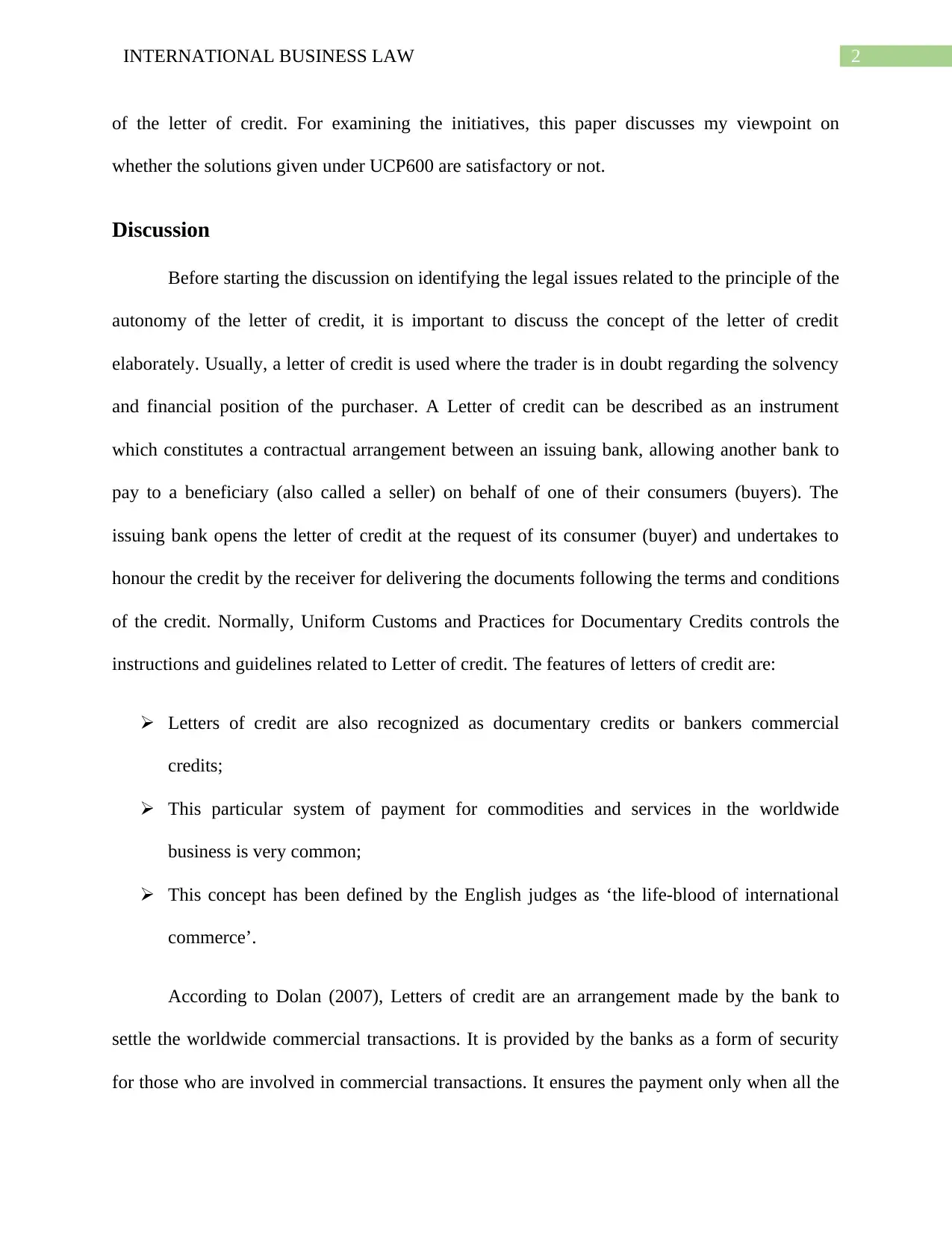
2INTERNATIONAL BUSINESS LAW
of the letter of credit. For examining the initiatives, this paper discusses my viewpoint on
whether the solutions given under UCP600 are satisfactory or not.
Discussion
Before starting the discussion on identifying the legal issues related to the principle of the
autonomy of the letter of credit, it is important to discuss the concept of the letter of credit
elaborately. Usually, a letter of credit is used where the trader is in doubt regarding the solvency
and financial position of the purchaser. A Letter of credit can be described as an instrument
which constitutes a contractual arrangement between an issuing bank, allowing another bank to
pay to a beneficiary (also called a seller) on behalf of one of their consumers (buyers). The
issuing bank opens the letter of credit at the request of its consumer (buyer) and undertakes to
honour the credit by the receiver for delivering the documents following the terms and conditions
of the credit. Normally, Uniform Customs and Practices for Documentary Credits controls the
instructions and guidelines related to Letter of credit. The features of letters of credit are:
Letters of credit are also recognized as documentary credits or bankers commercial
credits;
This particular system of payment for commodities and services in the worldwide
business is very common;
This concept has been defined by the English judges as ‘the life-blood of international
commerce’.
According to Dolan (2007), Letters of credit are an arrangement made by the bank to
settle the worldwide commercial transactions. It is provided by the banks as a form of security
for those who are involved in commercial transactions. It ensures the payment only when all the
of the letter of credit. For examining the initiatives, this paper discusses my viewpoint on
whether the solutions given under UCP600 are satisfactory or not.
Discussion
Before starting the discussion on identifying the legal issues related to the principle of the
autonomy of the letter of credit, it is important to discuss the concept of the letter of credit
elaborately. Usually, a letter of credit is used where the trader is in doubt regarding the solvency
and financial position of the purchaser. A Letter of credit can be described as an instrument
which constitutes a contractual arrangement between an issuing bank, allowing another bank to
pay to a beneficiary (also called a seller) on behalf of one of their consumers (buyers). The
issuing bank opens the letter of credit at the request of its consumer (buyer) and undertakes to
honour the credit by the receiver for delivering the documents following the terms and conditions
of the credit. Normally, Uniform Customs and Practices for Documentary Credits controls the
instructions and guidelines related to Letter of credit. The features of letters of credit are:
Letters of credit are also recognized as documentary credits or bankers commercial
credits;
This particular system of payment for commodities and services in the worldwide
business is very common;
This concept has been defined by the English judges as ‘the life-blood of international
commerce’.
According to Dolan (2007), Letters of credit are an arrangement made by the bank to
settle the worldwide commercial transactions. It is provided by the banks as a form of security
for those who are involved in commercial transactions. It ensures the payment only when all the
⊘ This is a preview!⊘
Do you want full access?
Subscribe today to unlock all pages.

Trusted by 1+ million students worldwide
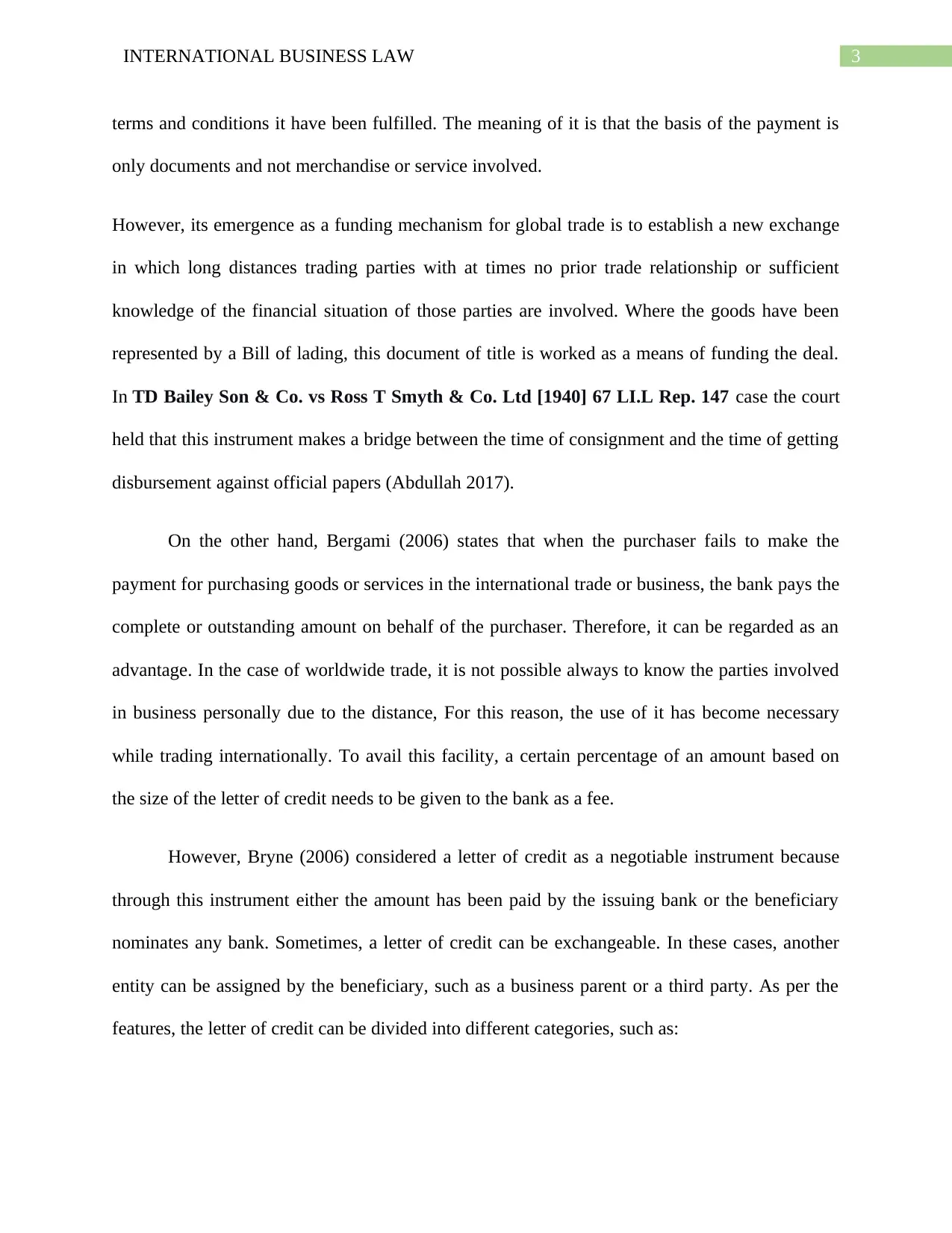
3INTERNATIONAL BUSINESS LAW
terms and conditions it have been fulfilled. The meaning of it is that the basis of the payment is
only documents and not merchandise or service involved.
However, its emergence as a funding mechanism for global trade is to establish a new exchange
in which long distances trading parties with at times no prior trade relationship or sufficient
knowledge of the financial situation of those parties are involved. Where the goods have been
represented by a Bill of lading, this document of title is worked as a means of funding the deal.
In TD Bailey Son & Co. vs Ross T Smyth & Co. Ltd [1940] 67 LI.L Rep. 147 case the court
held that this instrument makes a bridge between the time of consignment and the time of getting
disbursement against official papers (Abdullah 2017).
On the other hand, Bergami (2006) states that when the purchaser fails to make the
payment for purchasing goods or services in the international trade or business, the bank pays the
complete or outstanding amount on behalf of the purchaser. Therefore, it can be regarded as an
advantage. In the case of worldwide trade, it is not possible always to know the parties involved
in business personally due to the distance, For this reason, the use of it has become necessary
while trading internationally. To avail this facility, a certain percentage of an amount based on
the size of the letter of credit needs to be given to the bank as a fee.
However, Bryne (2006) considered a letter of credit as a negotiable instrument because
through this instrument either the amount has been paid by the issuing bank or the beneficiary
nominates any bank. Sometimes, a letter of credit can be exchangeable. In these cases, another
entity can be assigned by the beneficiary, such as a business parent or a third party. As per the
features, the letter of credit can be divided into different categories, such as:
terms and conditions it have been fulfilled. The meaning of it is that the basis of the payment is
only documents and not merchandise or service involved.
However, its emergence as a funding mechanism for global trade is to establish a new exchange
in which long distances trading parties with at times no prior trade relationship or sufficient
knowledge of the financial situation of those parties are involved. Where the goods have been
represented by a Bill of lading, this document of title is worked as a means of funding the deal.
In TD Bailey Son & Co. vs Ross T Smyth & Co. Ltd [1940] 67 LI.L Rep. 147 case the court
held that this instrument makes a bridge between the time of consignment and the time of getting
disbursement against official papers (Abdullah 2017).
On the other hand, Bergami (2006) states that when the purchaser fails to make the
payment for purchasing goods or services in the international trade or business, the bank pays the
complete or outstanding amount on behalf of the purchaser. Therefore, it can be regarded as an
advantage. In the case of worldwide trade, it is not possible always to know the parties involved
in business personally due to the distance, For this reason, the use of it has become necessary
while trading internationally. To avail this facility, a certain percentage of an amount based on
the size of the letter of credit needs to be given to the bank as a fee.
However, Bryne (2006) considered a letter of credit as a negotiable instrument because
through this instrument either the amount has been paid by the issuing bank or the beneficiary
nominates any bank. Sometimes, a letter of credit can be exchangeable. In these cases, another
entity can be assigned by the beneficiary, such as a business parent or a third party. As per the
features, the letter of credit can be divided into different categories, such as:
Paraphrase This Document
Need a fresh take? Get an instant paraphrase of this document with our AI Paraphraser
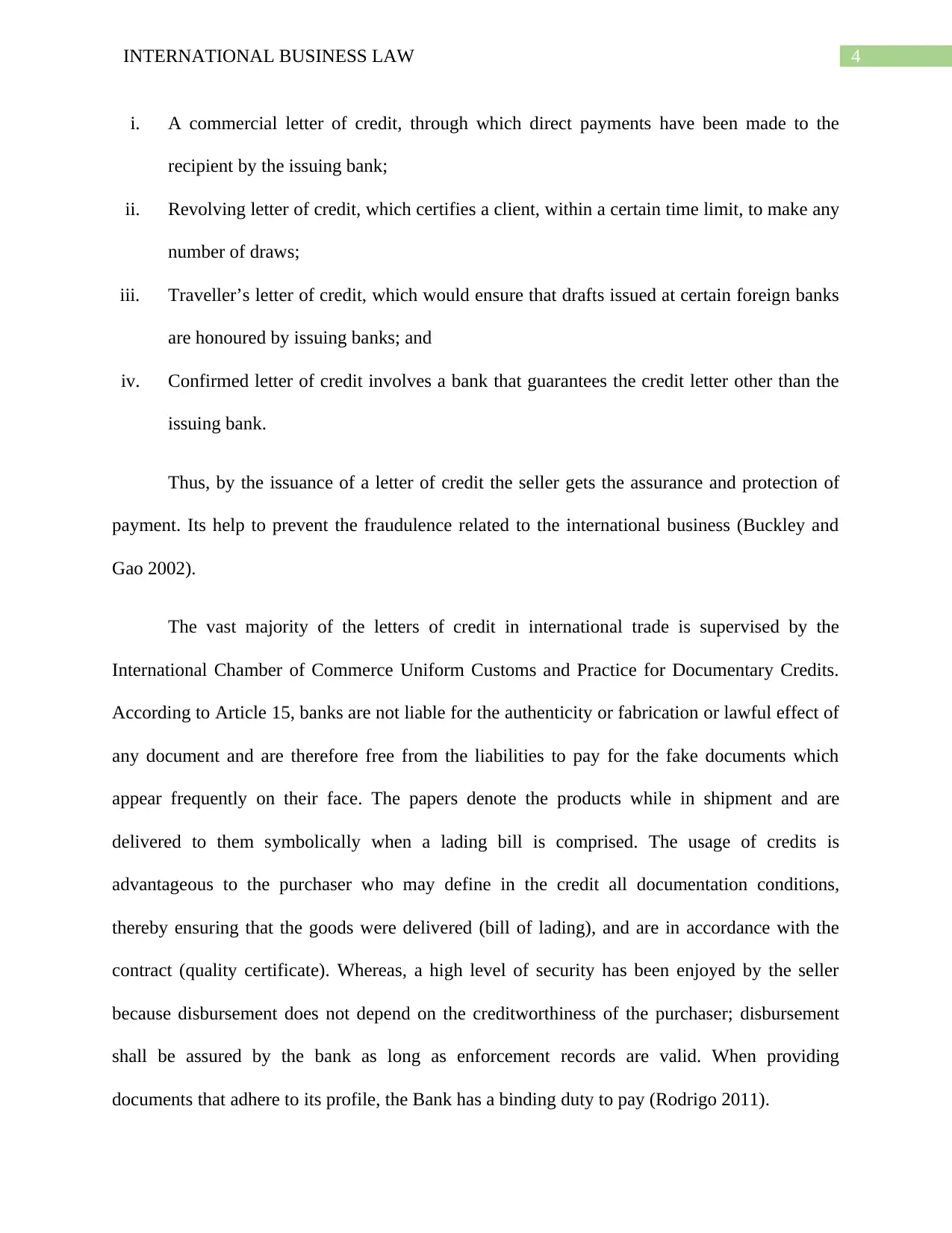
4INTERNATIONAL BUSINESS LAW
i. A commercial letter of credit, through which direct payments have been made to the
recipient by the issuing bank;
ii. Revolving letter of credit, which certifies a client, within a certain time limit, to make any
number of draws;
iii. Traveller’s letter of credit, which would ensure that drafts issued at certain foreign banks
are honoured by issuing banks; and
iv. Confirmed letter of credit involves a bank that guarantees the credit letter other than the
issuing bank.
Thus, by the issuance of a letter of credit the seller gets the assurance and protection of
payment. Its help to prevent the fraudulence related to the international business (Buckley and
Gao 2002).
The vast majority of the letters of credit in international trade is supervised by the
International Chamber of Commerce Uniform Customs and Practice for Documentary Credits.
According to Article 15, banks are not liable for the authenticity or fabrication or lawful effect of
any document and are therefore free from the liabilities to pay for the fake documents which
appear frequently on their face. The papers denote the products while in shipment and are
delivered to them symbolically when a lading bill is comprised. The usage of credits is
advantageous to the purchaser who may define in the credit all documentation conditions,
thereby ensuring that the goods were delivered (bill of lading), and are in accordance with the
contract (quality certificate). Whereas, a high level of security has been enjoyed by the seller
because disbursement does not depend on the creditworthiness of the purchaser; disbursement
shall be assured by the bank as long as enforcement records are valid. When providing
documents that adhere to its profile, the Bank has a binding duty to pay (Rodrigo 2011).
i. A commercial letter of credit, through which direct payments have been made to the
recipient by the issuing bank;
ii. Revolving letter of credit, which certifies a client, within a certain time limit, to make any
number of draws;
iii. Traveller’s letter of credit, which would ensure that drafts issued at certain foreign banks
are honoured by issuing banks; and
iv. Confirmed letter of credit involves a bank that guarantees the credit letter other than the
issuing bank.
Thus, by the issuance of a letter of credit the seller gets the assurance and protection of
payment. Its help to prevent the fraudulence related to the international business (Buckley and
Gao 2002).
The vast majority of the letters of credit in international trade is supervised by the
International Chamber of Commerce Uniform Customs and Practice for Documentary Credits.
According to Article 15, banks are not liable for the authenticity or fabrication or lawful effect of
any document and are therefore free from the liabilities to pay for the fake documents which
appear frequently on their face. The papers denote the products while in shipment and are
delivered to them symbolically when a lading bill is comprised. The usage of credits is
advantageous to the purchaser who may define in the credit all documentation conditions,
thereby ensuring that the goods were delivered (bill of lading), and are in accordance with the
contract (quality certificate). Whereas, a high level of security has been enjoyed by the seller
because disbursement does not depend on the creditworthiness of the purchaser; disbursement
shall be assured by the bank as long as enforcement records are valid. When providing
documents that adhere to its profile, the Bank has a binding duty to pay (Rodrigo 2011).
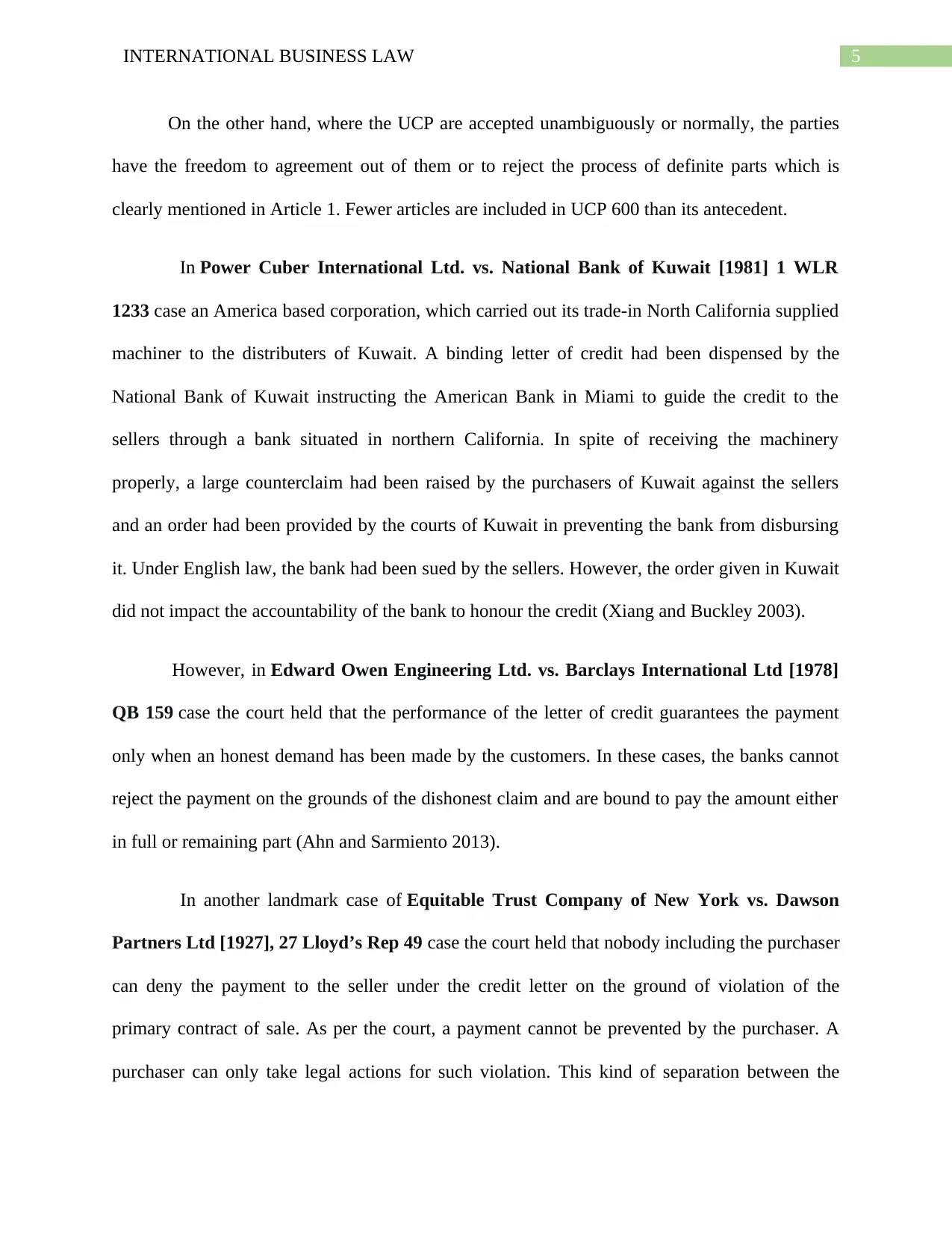
5INTERNATIONAL BUSINESS LAW
On the other hand, where the UCP are accepted unambiguously or normally, the parties
have the freedom to agreement out of them or to reject the process of definite parts which is
clearly mentioned in Article 1. Fewer articles are included in UCP 600 than its antecedent.
In Power Cuber International Ltd. vs. National Bank of Kuwait [1981] 1 WLR
1233 case an America based corporation, which carried out its trade-in North California supplied
machiner to the distributers of Kuwait. A binding letter of credit had been dispensed by the
National Bank of Kuwait instructing the American Bank in Miami to guide the credit to the
sellers through a bank situated in northern California. In spite of receiving the machinery
properly, a large counterclaim had been raised by the purchasers of Kuwait against the sellers
and an order had been provided by the courts of Kuwait in preventing the bank from disbursing
it. Under English law, the bank had been sued by the sellers. However, the order given in Kuwait
did not impact the accountability of the bank to honour the credit (Xiang and Buckley 2003).
However, in Edward Owen Engineering Ltd. vs. Barclays International Ltd [1978]
QB 159 case the court held that the performance of the letter of credit guarantees the payment
only when an honest demand has been made by the customers. In these cases, the banks cannot
reject the payment on the grounds of the dishonest claim and are bound to pay the amount either
in full or remaining part (Ahn and Sarmiento 2013).
In another landmark case of Equitable Trust Company of New York vs. Dawson
Partners Ltd [1927], 27 Lloyd’s Rep 49 case the court held that nobody including the purchaser
can deny the payment to the seller under the credit letter on the ground of violation of the
primary contract of sale. As per the court, a payment cannot be prevented by the purchaser. A
purchaser can only take legal actions for such violation. This kind of separation between the
On the other hand, where the UCP are accepted unambiguously or normally, the parties
have the freedom to agreement out of them or to reject the process of definite parts which is
clearly mentioned in Article 1. Fewer articles are included in UCP 600 than its antecedent.
In Power Cuber International Ltd. vs. National Bank of Kuwait [1981] 1 WLR
1233 case an America based corporation, which carried out its trade-in North California supplied
machiner to the distributers of Kuwait. A binding letter of credit had been dispensed by the
National Bank of Kuwait instructing the American Bank in Miami to guide the credit to the
sellers through a bank situated in northern California. In spite of receiving the machinery
properly, a large counterclaim had been raised by the purchasers of Kuwait against the sellers
and an order had been provided by the courts of Kuwait in preventing the bank from disbursing
it. Under English law, the bank had been sued by the sellers. However, the order given in Kuwait
did not impact the accountability of the bank to honour the credit (Xiang and Buckley 2003).
However, in Edward Owen Engineering Ltd. vs. Barclays International Ltd [1978]
QB 159 case the court held that the performance of the letter of credit guarantees the payment
only when an honest demand has been made by the customers. In these cases, the banks cannot
reject the payment on the grounds of the dishonest claim and are bound to pay the amount either
in full or remaining part (Ahn and Sarmiento 2013).
In another landmark case of Equitable Trust Company of New York vs. Dawson
Partners Ltd [1927], 27 Lloyd’s Rep 49 case the court held that nobody including the purchaser
can deny the payment to the seller under the credit letter on the ground of violation of the
primary contract of sale. As per the court, a payment cannot be prevented by the purchaser. A
purchaser can only take legal actions for such violation. This kind of separation between the
⊘ This is a preview!⊘
Do you want full access?
Subscribe today to unlock all pages.

Trusted by 1+ million students worldwide
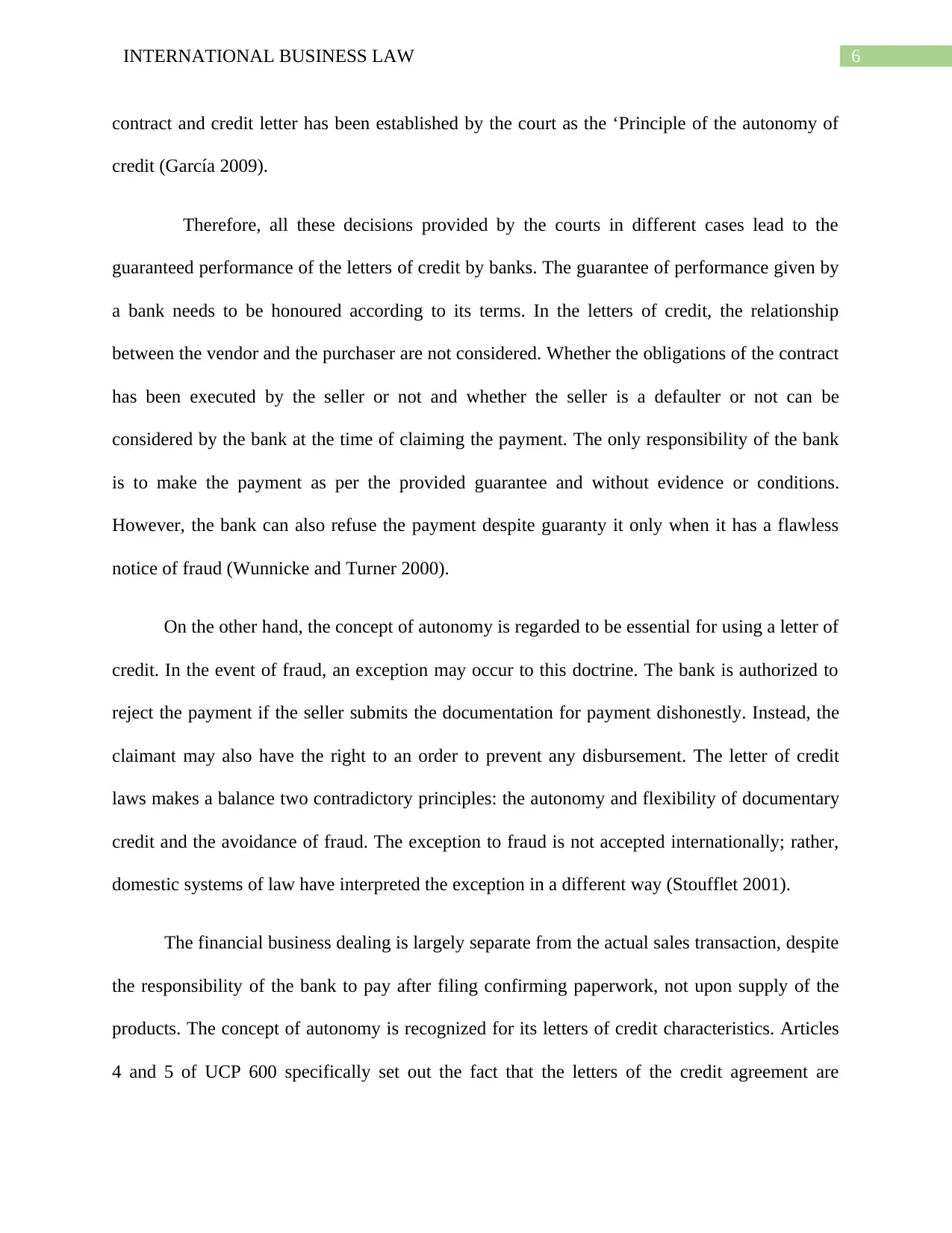
6INTERNATIONAL BUSINESS LAW
contract and credit letter has been established by the court as the ‘Principle of the autonomy of
credit (García 2009).
Therefore, all these decisions provided by the courts in different cases lead to the
guaranteed performance of the letters of credit by banks. The guarantee of performance given by
a bank needs to be honoured according to its terms. In the letters of credit, the relationship
between the vendor and the purchaser are not considered. Whether the obligations of the contract
has been executed by the seller or not and whether the seller is a defaulter or not can be
considered by the bank at the time of claiming the payment. The only responsibility of the bank
is to make the payment as per the provided guarantee and without evidence or conditions.
However, the bank can also refuse the payment despite guaranty it only when it has a flawless
notice of fraud (Wunnicke and Turner 2000).
On the other hand, the concept of autonomy is regarded to be essential for using a letter of
credit. In the event of fraud, an exception may occur to this doctrine. The bank is authorized to
reject the payment if the seller submits the documentation for payment dishonestly. Instead, the
claimant may also have the right to an order to prevent any disbursement. The letter of credit
laws makes a balance two contradictory principles: the autonomy and flexibility of documentary
credit and the avoidance of fraud. The exception to fraud is not accepted internationally; rather,
domestic systems of law have interpreted the exception in a different way (Stoufflet 2001).
The financial business dealing is largely separate from the actual sales transaction, despite
the responsibility of the bank to pay after filing confirming paperwork, not upon supply of the
products. The concept of autonomy is recognized for its letters of credit characteristics. Articles
4 and 5 of UCP 600 specifically set out the fact that the letters of the credit agreement are
contract and credit letter has been established by the court as the ‘Principle of the autonomy of
credit (García 2009).
Therefore, all these decisions provided by the courts in different cases lead to the
guaranteed performance of the letters of credit by banks. The guarantee of performance given by
a bank needs to be honoured according to its terms. In the letters of credit, the relationship
between the vendor and the purchaser are not considered. Whether the obligations of the contract
has been executed by the seller or not and whether the seller is a defaulter or not can be
considered by the bank at the time of claiming the payment. The only responsibility of the bank
is to make the payment as per the provided guarantee and without evidence or conditions.
However, the bank can also refuse the payment despite guaranty it only when it has a flawless
notice of fraud (Wunnicke and Turner 2000).
On the other hand, the concept of autonomy is regarded to be essential for using a letter of
credit. In the event of fraud, an exception may occur to this doctrine. The bank is authorized to
reject the payment if the seller submits the documentation for payment dishonestly. Instead, the
claimant may also have the right to an order to prevent any disbursement. The letter of credit
laws makes a balance two contradictory principles: the autonomy and flexibility of documentary
credit and the avoidance of fraud. The exception to fraud is not accepted internationally; rather,
domestic systems of law have interpreted the exception in a different way (Stoufflet 2001).
The financial business dealing is largely separate from the actual sales transaction, despite
the responsibility of the bank to pay after filing confirming paperwork, not upon supply of the
products. The concept of autonomy is recognized for its letters of credit characteristics. Articles
4 and 5 of UCP 600 specifically set out the fact that the letters of the credit agreement are
Paraphrase This Document
Need a fresh take? Get an instant paraphrase of this document with our AI Paraphraser
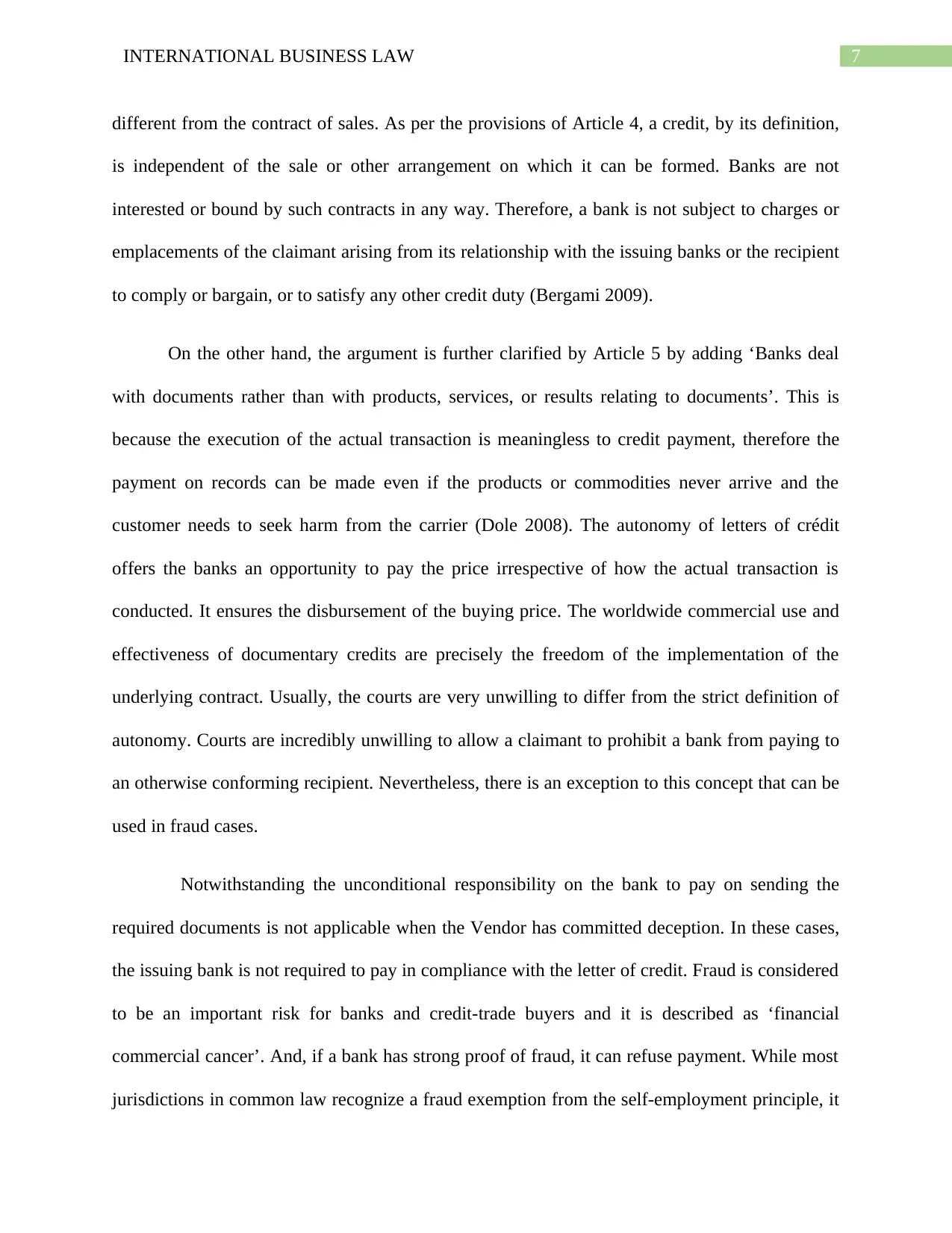
7INTERNATIONAL BUSINESS LAW
different from the contract of sales. As per the provisions of Article 4, a credit, by its definition,
is independent of the sale or other arrangement on which it can be formed. Banks are not
interested or bound by such contracts in any way. Therefore, a bank is not subject to charges or
emplacements of the claimant arising from its relationship with the issuing banks or the recipient
to comply or bargain, or to satisfy any other credit duty (Bergami 2009).
On the other hand, the argument is further clarified by Article 5 by adding ‘Banks deal
with documents rather than with products, services, or results relating to documents’. This is
because the execution of the actual transaction is meaningless to credit payment, therefore the
payment on records can be made even if the products or commodities never arrive and the
customer needs to seek harm from the carrier (Dole 2008). The autonomy of letters of crédit
offers the banks an opportunity to pay the price irrespective of how the actual transaction is
conducted. It ensures the disbursement of the buying price. The worldwide commercial use and
effectiveness of documentary credits are precisely the freedom of the implementation of the
underlying contract. Usually, the courts are very unwilling to differ from the strict definition of
autonomy. Courts are incredibly unwilling to allow a claimant to prohibit a bank from paying to
an otherwise conforming recipient. Nevertheless, there is an exception to this concept that can be
used in fraud cases.
Notwithstanding the unconditional responsibility on the bank to pay on sending the
required documents is not applicable when the Vendor has committed deception. In these cases,
the issuing bank is not required to pay in compliance with the letter of credit. Fraud is considered
to be an important risk for banks and credit-trade buyers and it is described as ‘financial
commercial cancer’. And, if a bank has strong proof of fraud, it can refuse payment. While most
jurisdictions in common law recognize a fraud exemption from the self-employment principle, it
different from the contract of sales. As per the provisions of Article 4, a credit, by its definition,
is independent of the sale or other arrangement on which it can be formed. Banks are not
interested or bound by such contracts in any way. Therefore, a bank is not subject to charges or
emplacements of the claimant arising from its relationship with the issuing banks or the recipient
to comply or bargain, or to satisfy any other credit duty (Bergami 2009).
On the other hand, the argument is further clarified by Article 5 by adding ‘Banks deal
with documents rather than with products, services, or results relating to documents’. This is
because the execution of the actual transaction is meaningless to credit payment, therefore the
payment on records can be made even if the products or commodities never arrive and the
customer needs to seek harm from the carrier (Dole 2008). The autonomy of letters of crédit
offers the banks an opportunity to pay the price irrespective of how the actual transaction is
conducted. It ensures the disbursement of the buying price. The worldwide commercial use and
effectiveness of documentary credits are precisely the freedom of the implementation of the
underlying contract. Usually, the courts are very unwilling to differ from the strict definition of
autonomy. Courts are incredibly unwilling to allow a claimant to prohibit a bank from paying to
an otherwise conforming recipient. Nevertheless, there is an exception to this concept that can be
used in fraud cases.
Notwithstanding the unconditional responsibility on the bank to pay on sending the
required documents is not applicable when the Vendor has committed deception. In these cases,
the issuing bank is not required to pay in compliance with the letter of credit. Fraud is considered
to be an important risk for banks and credit-trade buyers and it is described as ‘financial
commercial cancer’. And, if a bank has strong proof of fraud, it can refuse payment. While most
jurisdictions in common law recognize a fraud exemption from the self-employment principle, it
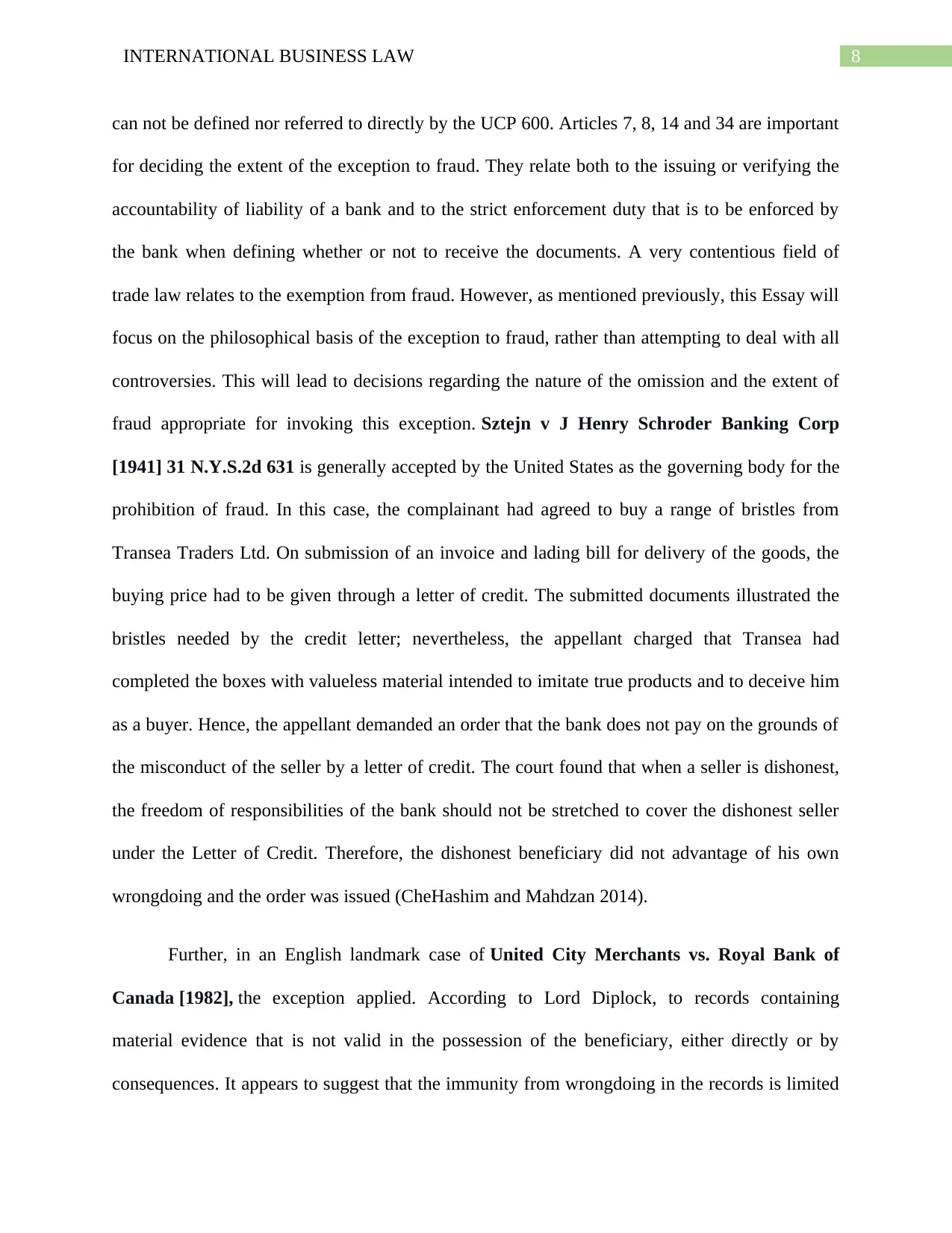
8INTERNATIONAL BUSINESS LAW
can not be defined nor referred to directly by the UCP 600. Articles 7, 8, 14 and 34 are important
for deciding the extent of the exception to fraud. They relate both to the issuing or verifying the
accountability of liability of a bank and to the strict enforcement duty that is to be enforced by
the bank when defining whether or not to receive the documents. A very contentious field of
trade law relates to the exemption from fraud. However, as mentioned previously, this Essay will
focus on the philosophical basis of the exception to fraud, rather than attempting to deal with all
controversies. This will lead to decisions regarding the nature of the omission and the extent of
fraud appropriate for invoking this exception. Sztejn v J Henry Schroder Banking Corp
[1941] 31 N.Y.S.2d 631 is generally accepted by the United States as the governing body for the
prohibition of fraud. In this case, the complainant had agreed to buy a range of bristles from
Transea Traders Ltd. On submission of an invoice and lading bill for delivery of the goods, the
buying price had to be given through a letter of credit. The submitted documents illustrated the
bristles needed by the credit letter; nevertheless, the appellant charged that Transea had
completed the boxes with valueless material intended to imitate true products and to deceive him
as a buyer. Hence, the appellant demanded an order that the bank does not pay on the grounds of
the misconduct of the seller by a letter of credit. The court found that when a seller is dishonest,
the freedom of responsibilities of the bank should not be stretched to cover the dishonest seller
under the Letter of Credit. Therefore, the dishonest beneficiary did not advantage of his own
wrongdoing and the order was issued (CheHashim and Mahdzan 2014).
Further, in an English landmark case of United City Merchants vs. Royal Bank of
Canada [1982], the exception applied. According to Lord Diplock, to records containing
material evidence that is not valid in the possession of the beneficiary, either directly or by
consequences. It appears to suggest that the immunity from wrongdoing in the records is limited
can not be defined nor referred to directly by the UCP 600. Articles 7, 8, 14 and 34 are important
for deciding the extent of the exception to fraud. They relate both to the issuing or verifying the
accountability of liability of a bank and to the strict enforcement duty that is to be enforced by
the bank when defining whether or not to receive the documents. A very contentious field of
trade law relates to the exemption from fraud. However, as mentioned previously, this Essay will
focus on the philosophical basis of the exception to fraud, rather than attempting to deal with all
controversies. This will lead to decisions regarding the nature of the omission and the extent of
fraud appropriate for invoking this exception. Sztejn v J Henry Schroder Banking Corp
[1941] 31 N.Y.S.2d 631 is generally accepted by the United States as the governing body for the
prohibition of fraud. In this case, the complainant had agreed to buy a range of bristles from
Transea Traders Ltd. On submission of an invoice and lading bill for delivery of the goods, the
buying price had to be given through a letter of credit. The submitted documents illustrated the
bristles needed by the credit letter; nevertheless, the appellant charged that Transea had
completed the boxes with valueless material intended to imitate true products and to deceive him
as a buyer. Hence, the appellant demanded an order that the bank does not pay on the grounds of
the misconduct of the seller by a letter of credit. The court found that when a seller is dishonest,
the freedom of responsibilities of the bank should not be stretched to cover the dishonest seller
under the Letter of Credit. Therefore, the dishonest beneficiary did not advantage of his own
wrongdoing and the order was issued (CheHashim and Mahdzan 2014).
Further, in an English landmark case of United City Merchants vs. Royal Bank of
Canada [1982], the exception applied. According to Lord Diplock, to records containing
material evidence that is not valid in the possession of the beneficiary, either directly or by
consequences. It appears to suggest that the immunity from wrongdoing in the records is limited
⊘ This is a preview!⊘
Do you want full access?
Subscribe today to unlock all pages.

Trusted by 1+ million students worldwide
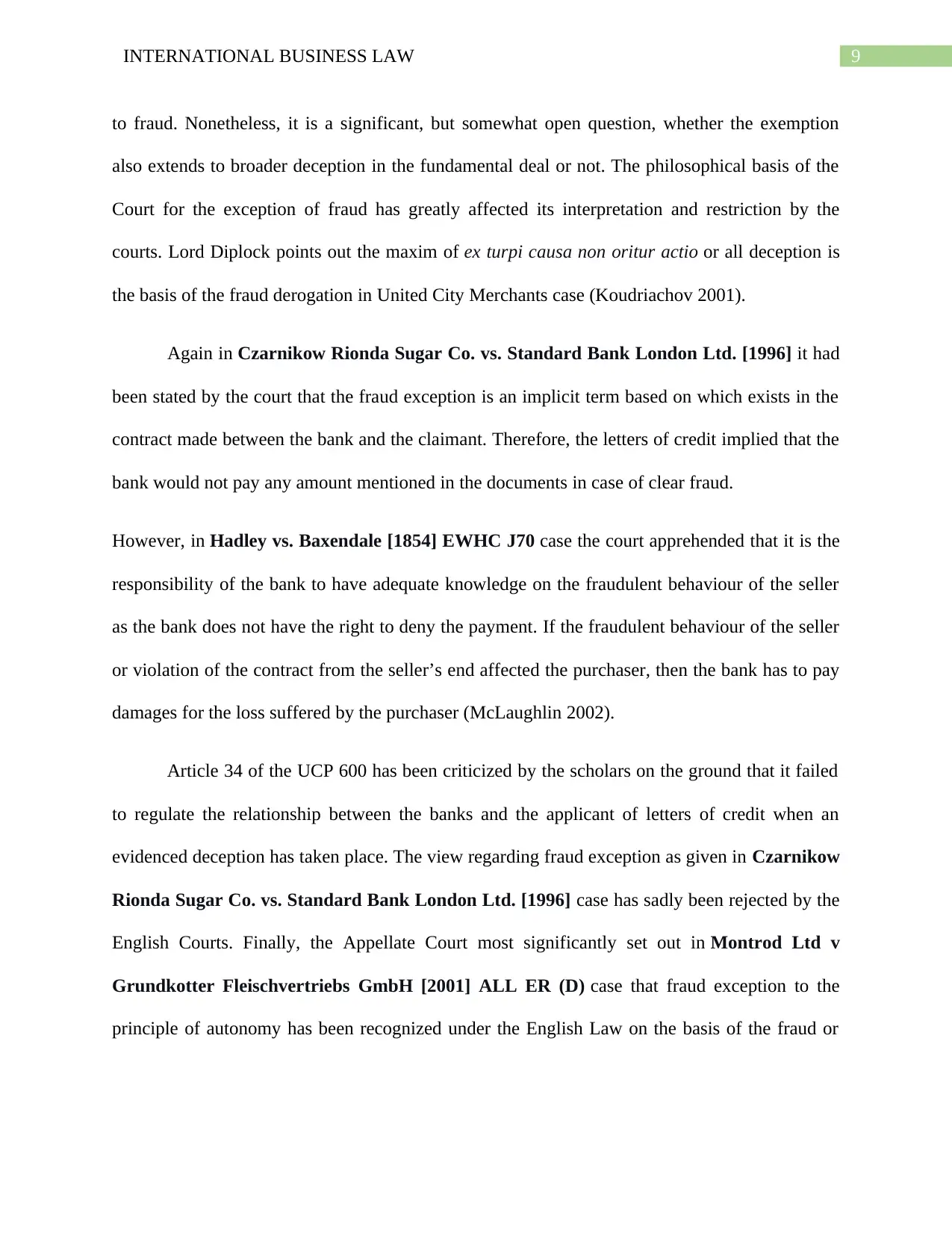
9INTERNATIONAL BUSINESS LAW
to fraud. Nonetheless, it is a significant, but somewhat open question, whether the exemption
also extends to broader deception in the fundamental deal or not. The philosophical basis of the
Court for the exception of fraud has greatly affected its interpretation and restriction by the
courts. Lord Diplock points out the maxim of ex turpi causa non oritur actio or all deception is
the basis of the fraud derogation in United City Merchants case (Koudriachov 2001).
Again in Czarnikow Rionda Sugar Co. vs. Standard Bank London Ltd. [1996] it had
been stated by the court that the fraud exception is an implicit term based on which exists in the
contract made between the bank and the claimant. Therefore, the letters of credit implied that the
bank would not pay any amount mentioned in the documents in case of clear fraud.
However, in Hadley vs. Baxendale [1854] EWHC J70 case the court apprehended that it is the
responsibility of the bank to have adequate knowledge on the fraudulent behaviour of the seller
as the bank does not have the right to deny the payment. If the fraudulent behaviour of the seller
or violation of the contract from the seller’s end affected the purchaser, then the bank has to pay
damages for the loss suffered by the purchaser (McLaughlin 2002).
Article 34 of the UCP 600 has been criticized by the scholars on the ground that it failed
to regulate the relationship between the banks and the applicant of letters of credit when an
evidenced deception has taken place. The view regarding fraud exception as given in Czarnikow
Rionda Sugar Co. vs. Standard Bank London Ltd. [1996] case has sadly been rejected by the
English Courts. Finally, the Appellate Court most significantly set out in Montrod Ltd v
Grundkotter Fleischvertriebs GmbH [2001] ALL ER (D) case that fraud exception to the
principle of autonomy has been recognized under the English Law on the basis of the fraud or
to fraud. Nonetheless, it is a significant, but somewhat open question, whether the exemption
also extends to broader deception in the fundamental deal or not. The philosophical basis of the
Court for the exception of fraud has greatly affected its interpretation and restriction by the
courts. Lord Diplock points out the maxim of ex turpi causa non oritur actio or all deception is
the basis of the fraud derogation in United City Merchants case (Koudriachov 2001).
Again in Czarnikow Rionda Sugar Co. vs. Standard Bank London Ltd. [1996] it had
been stated by the court that the fraud exception is an implicit term based on which exists in the
contract made between the bank and the claimant. Therefore, the letters of credit implied that the
bank would not pay any amount mentioned in the documents in case of clear fraud.
However, in Hadley vs. Baxendale [1854] EWHC J70 case the court apprehended that it is the
responsibility of the bank to have adequate knowledge on the fraudulent behaviour of the seller
as the bank does not have the right to deny the payment. If the fraudulent behaviour of the seller
or violation of the contract from the seller’s end affected the purchaser, then the bank has to pay
damages for the loss suffered by the purchaser (McLaughlin 2002).
Article 34 of the UCP 600 has been criticized by the scholars on the ground that it failed
to regulate the relationship between the banks and the applicant of letters of credit when an
evidenced deception has taken place. The view regarding fraud exception as given in Czarnikow
Rionda Sugar Co. vs. Standard Bank London Ltd. [1996] case has sadly been rejected by the
English Courts. Finally, the Appellate Court most significantly set out in Montrod Ltd v
Grundkotter Fleischvertriebs GmbH [2001] ALL ER (D) case that fraud exception to the
principle of autonomy has been recognized under the English Law on the basis of the fraud or
Paraphrase This Document
Need a fresh take? Get an instant paraphrase of this document with our AI Paraphraser
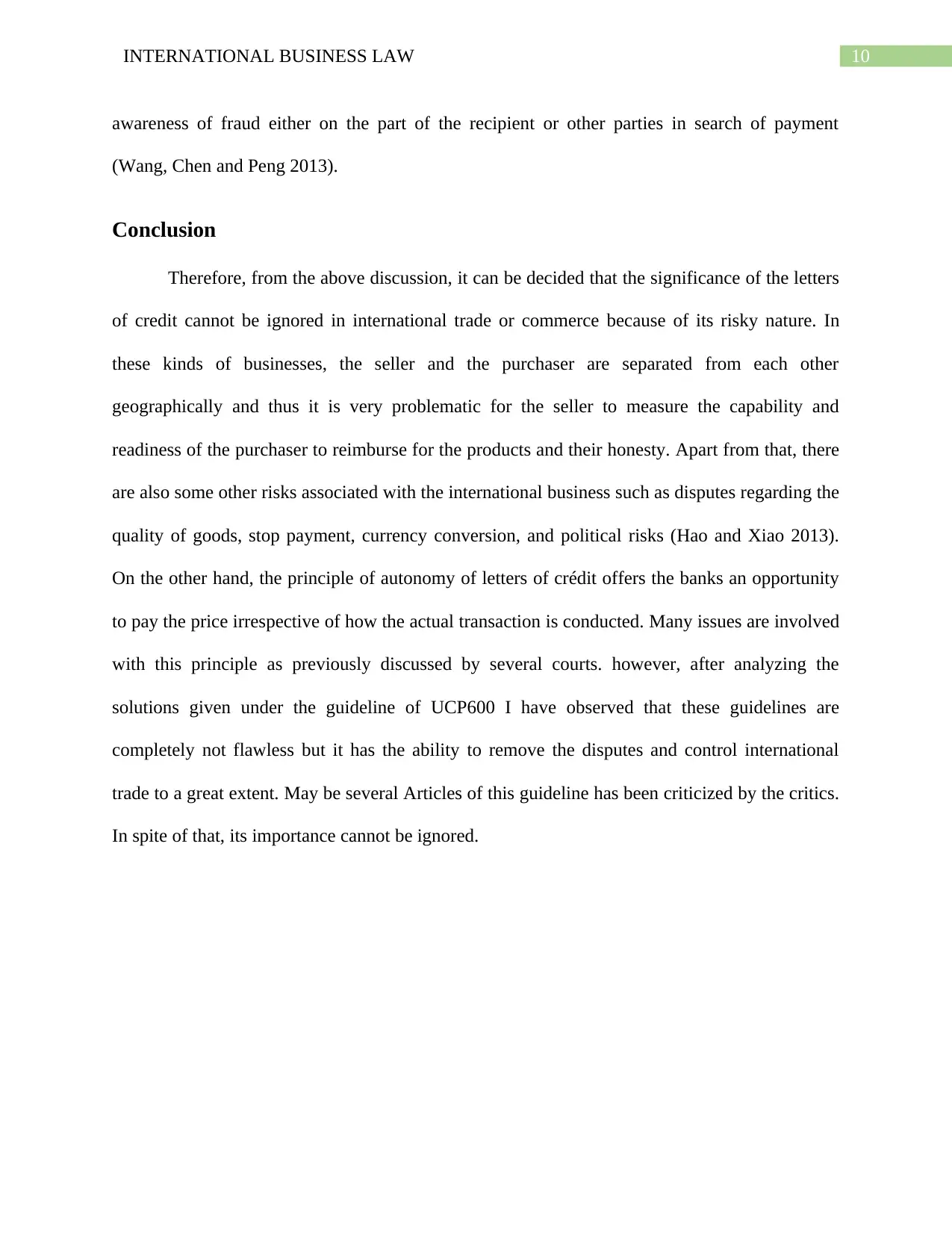
10INTERNATIONAL BUSINESS LAW
awareness of fraud either on the part of the recipient or other parties in search of payment
(Wang, Chen and Peng 2013).
Conclusion
Therefore, from the above discussion, it can be decided that the significance of the letters
of credit cannot be ignored in international trade or commerce because of its risky nature. In
these kinds of businesses, the seller and the purchaser are separated from each other
geographically and thus it is very problematic for the seller to measure the capability and
readiness of the purchaser to reimburse for the products and their honesty. Apart from that, there
are also some other risks associated with the international business such as disputes regarding the
quality of goods, stop payment, currency conversion, and political risks (Hao and Xiao 2013).
On the other hand, the principle of autonomy of letters of crédit offers the banks an opportunity
to pay the price irrespective of how the actual transaction is conducted. Many issues are involved
with this principle as previously discussed by several courts. however, after analyzing the
solutions given under the guideline of UCP600 I have observed that these guidelines are
completely not flawless but it has the ability to remove the disputes and control international
trade to a great extent. May be several Articles of this guideline has been criticized by the critics.
In spite of that, its importance cannot be ignored.
awareness of fraud either on the part of the recipient or other parties in search of payment
(Wang, Chen and Peng 2013).
Conclusion
Therefore, from the above discussion, it can be decided that the significance of the letters
of credit cannot be ignored in international trade or commerce because of its risky nature. In
these kinds of businesses, the seller and the purchaser are separated from each other
geographically and thus it is very problematic for the seller to measure the capability and
readiness of the purchaser to reimburse for the products and their honesty. Apart from that, there
are also some other risks associated with the international business such as disputes regarding the
quality of goods, stop payment, currency conversion, and political risks (Hao and Xiao 2013).
On the other hand, the principle of autonomy of letters of crédit offers the banks an opportunity
to pay the price irrespective of how the actual transaction is conducted. Many issues are involved
with this principle as previously discussed by several courts. however, after analyzing the
solutions given under the guideline of UCP600 I have observed that these guidelines are
completely not flawless but it has the ability to remove the disputes and control international
trade to a great extent. May be several Articles of this guideline has been criticized by the critics.
In spite of that, its importance cannot be ignored.
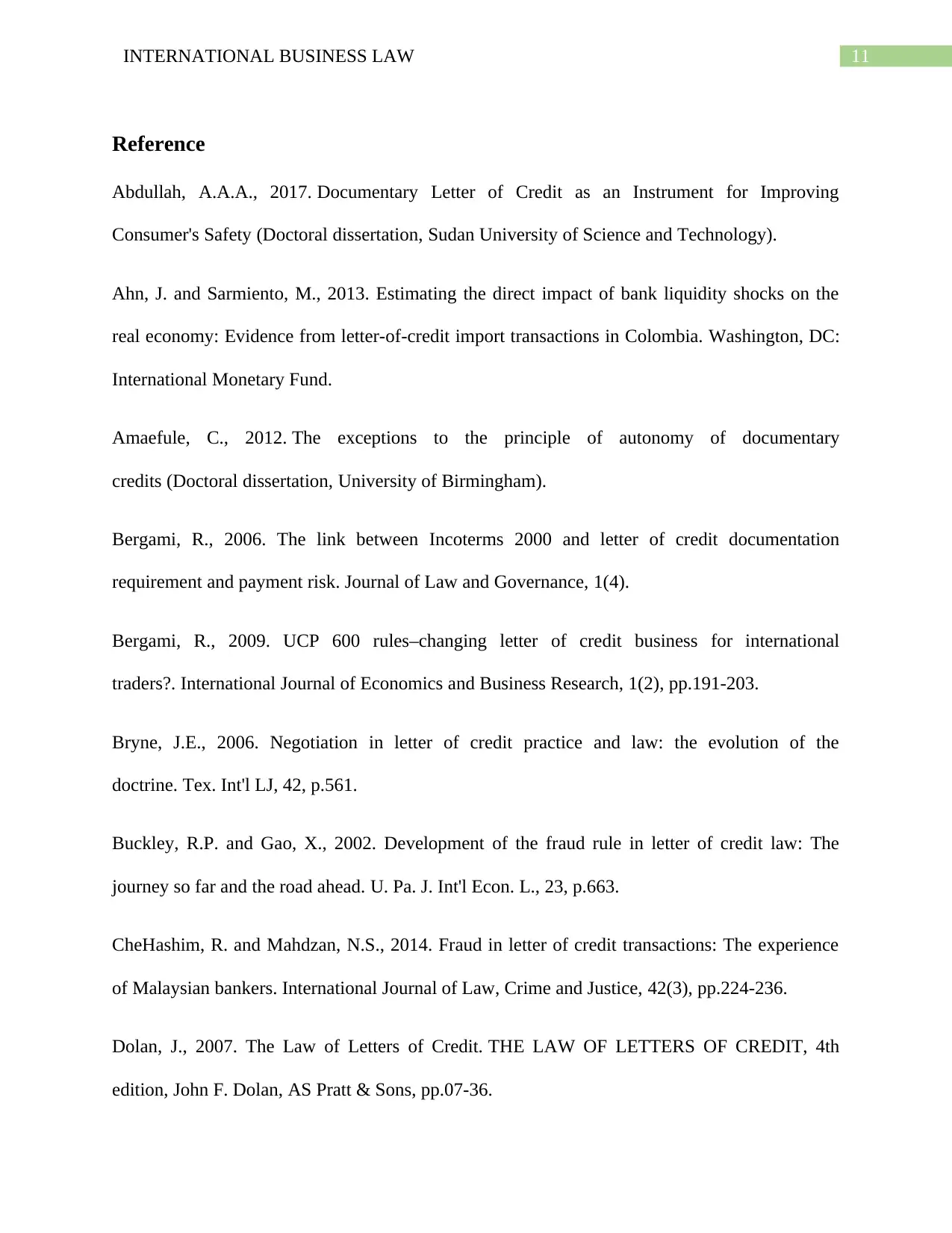
11INTERNATIONAL BUSINESS LAW
Reference
Abdullah, A.A.A., 2017. Documentary Letter of Credit as an Instrument for Improving
Consumer's Safety (Doctoral dissertation, Sudan University of Science and Technology).
Ahn, J. and Sarmiento, M., 2013. Estimating the direct impact of bank liquidity shocks on the
real economy: Evidence from letter-of-credit import transactions in Colombia. Washington, DC:
International Monetary Fund.
Amaefule, C., 2012. The exceptions to the principle of autonomy of documentary
credits (Doctoral dissertation, University of Birmingham).
Bergami, R., 2006. The link between Incoterms 2000 and letter of credit documentation
requirement and payment risk. Journal of Law and Governance, 1(4).
Bergami, R., 2009. UCP 600 rules–changing letter of credit business for international
traders?. International Journal of Economics and Business Research, 1(2), pp.191-203.
Bryne, J.E., 2006. Negotiation in letter of credit practice and law: the evolution of the
doctrine. Tex. Int'l LJ, 42, p.561.
Buckley, R.P. and Gao, X., 2002. Development of the fraud rule in letter of credit law: The
journey so far and the road ahead. U. Pa. J. Int'l Econ. L., 23, p.663.
CheHashim, R. and Mahdzan, N.S., 2014. Fraud in letter of credit transactions: The experience
of Malaysian bankers. International Journal of Law, Crime and Justice, 42(3), pp.224-236.
Dolan, J., 2007. The Law of Letters of Credit. THE LAW OF LETTERS OF CREDIT, 4th
edition, John F. Dolan, AS Pratt & Sons, pp.07-36.
Reference
Abdullah, A.A.A., 2017. Documentary Letter of Credit as an Instrument for Improving
Consumer's Safety (Doctoral dissertation, Sudan University of Science and Technology).
Ahn, J. and Sarmiento, M., 2013. Estimating the direct impact of bank liquidity shocks on the
real economy: Evidence from letter-of-credit import transactions in Colombia. Washington, DC:
International Monetary Fund.
Amaefule, C., 2012. The exceptions to the principle of autonomy of documentary
credits (Doctoral dissertation, University of Birmingham).
Bergami, R., 2006. The link between Incoterms 2000 and letter of credit documentation
requirement and payment risk. Journal of Law and Governance, 1(4).
Bergami, R., 2009. UCP 600 rules–changing letter of credit business for international
traders?. International Journal of Economics and Business Research, 1(2), pp.191-203.
Bryne, J.E., 2006. Negotiation in letter of credit practice and law: the evolution of the
doctrine. Tex. Int'l LJ, 42, p.561.
Buckley, R.P. and Gao, X., 2002. Development of the fraud rule in letter of credit law: The
journey so far and the road ahead. U. Pa. J. Int'l Econ. L., 23, p.663.
CheHashim, R. and Mahdzan, N.S., 2014. Fraud in letter of credit transactions: The experience
of Malaysian bankers. International Journal of Law, Crime and Justice, 42(3), pp.224-236.
Dolan, J., 2007. The Law of Letters of Credit. THE LAW OF LETTERS OF CREDIT, 4th
edition, John F. Dolan, AS Pratt & Sons, pp.07-36.
⊘ This is a preview!⊘
Do you want full access?
Subscribe today to unlock all pages.

Trusted by 1+ million students worldwide
1 out of 14
Related Documents
Your All-in-One AI-Powered Toolkit for Academic Success.
+13062052269
info@desklib.com
Available 24*7 on WhatsApp / Email
![[object Object]](/_next/static/media/star-bottom.7253800d.svg)
Unlock your academic potential
Copyright © 2020–2025 A2Z Services. All Rights Reserved. Developed and managed by ZUCOL.





